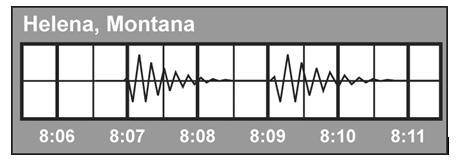
Determine the difference in time between the arrival of the P waves and arrival of the S waves from the earthquake.
Use a travel-time graph to determine how far each seismograph station is from the epicenter.
Use the technique of triangulation to pinpoint the location of the quake.
Below is data from one of the stations to pick up the waves. It is located in Helena, Montana. The first set of squiggly lines represent the P wave while the 2nd set of squiggly lines represent the S wave (which moves slower). What is the time difference between the arrival of the P wave and the S wave? (remember reference the difference from where each wave BEGINS)
Question 1 options:
1 minute
1.5 minutes
2 minutes
2.5 minutes


Answers: 1


Another question on Biology

Biology, 21.06.2019 18:30
Which would be an adaptation in a rainforest, but not in a tundra? a. ability to store water for a long time b. fur that blends in with snow c. strong claws for killing prey d. a beak that can dig into thick trees
Answers: 2

Biology, 22.06.2019 08:00
Pls in your opinion, what are the limiting factors that might affect the growth or diversity of our ecosystem? respond to this question in claim, evidence, reasoning format. 1. make your claim (i are the limiting factors that might affect the growth or diversity of our 2. follow the claim with 3 pieces of evidence. evidence may be taken from the reading, the videos, previous lessons, or googled answers. site sources, too. 3. use reasoning to explain why you chose your evidence.
Answers: 3

Biology, 22.06.2019 09:40
Explain how paleontologists use trilobite fossils as index fossils for various geologic time periods.
Answers: 1

Biology, 22.06.2019 17:00
Astudent completed a lab report. which correctly describes the difference between the “question” and “hypothesis” sections of her report? “question” states what she is asking, and “hypothesis” states the result of her experiment. “question” states what she is asking, and “hypothesis” states what she thinks the answer to that question is in “if . . then . . because” format. “question” describes what she is trying to find out, and "hypothesis" states the procedures and methods of data collection. “question” describes what she is trying to find out, and “hypothesis” states any additional information or prior knowledge about the question.
Answers: 1
You know the right answer?
Determine the difference in time between the arrival of the P waves and arrival of the S waves from...
Questions

Mathematics, 21.08.2019 03:40

Mathematics, 21.08.2019 03:40


Geography, 21.08.2019 03:40

Social Studies, 21.08.2019 03:40

Chemistry, 21.08.2019 03:40

History, 21.08.2019 03:40

Biology, 21.08.2019 03:40


History, 21.08.2019 03:40

Mathematics, 21.08.2019 03:40

History, 21.08.2019 03:40






World Languages, 21.08.2019 03:40

History, 21.08.2019 03:40

History, 21.08.2019 03:40



